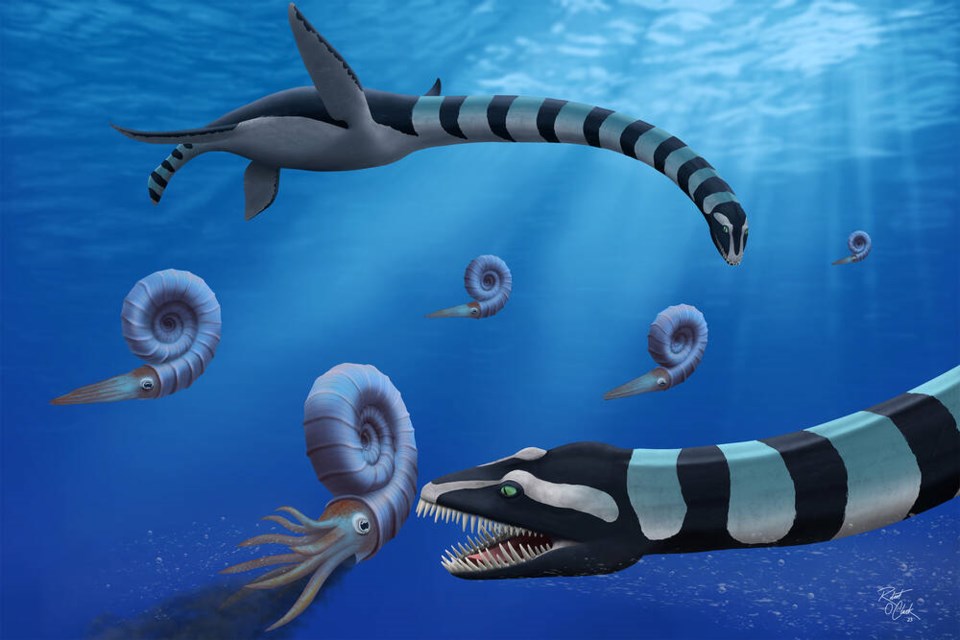When Pat Trask begins his tours at the cultural and natural history museum in Courtenay, he always tells visitors his fossil tours only exist because of a discovery by a father-daughter duo.
The pair he’s referring to are his twin brother and niece, Mike and Heather Trask, who in 1988 discovered fossils in the Puntledge River that turned out to be the bones of an elasmosaur, an extinct marine reptile with a long neck that lived about 85 million years ago.
Scientists suspected the fossils were a new species of elasmosaur, but didn’t have enough evidence to support the claim until a few years ago, when Pat Trask, the curator of natural history at the Courtenay District Museum and Paleontology Centre, discovered fossilized remains of a well-preserved juvenile skeleton not far from his brother’s find.
Through a friend, Trask was connected with F. Robin O’Keefe, a biology professor at Marshall University in West Virginia and an expert on marine reptiles from the age of dinosaurs.
O’Keefe flew out to Courtenay to examine the fossils. Although the first discovery was a nearly complete skeleton, it was in poor condition, like “melted ice cream,” making it challenging to put forward a claim for a new species based on it alone, O’Keefe said.
The second was in great shape and allowed O’Keefe and his colleagues to confirm the remains belonged to a previously unnamed species of elasmosaur.
“It took a long time. It was a very challenging project to try to figure out what the heck this thing was, and what was going on with its shoulder, and what was going on with its flippers and why it was so strange,” he said.
Even for an expert on plesiosaurs, a group of extinct marine reptiles O’Keefe likens to a “Mesozoic version of whales” to which elasmosaurs belong, there was “a lot of head scratching” to figure out what he was dealing with.
The shoulder was unlike any he had seen on a plesiosaur and the flippers were curved on the bottom, indicating they were built for downward swimming, O’Keefe said.
Based on the discoveries, O’Keefe and his colleagues determined the animal was a fast and “voracious” predator that would float around the surface of the water and hunt visually for squid, ammonite and fish before diving down to catch its prey, O’Keefe said.
It was about 12 metres long, around the size of an orca, but most of that was neck — its body was only about two to three metres.
It had a small head, requiring it to eat lots of small prey that it likely crushed with sharp, robust teeth. The animal lived exclusively in the water, with a swimming style similar to a penguin, he said.
O’Keefe and his colleagues recently published a paper in the Journal of Systematic Paleontology, naming the new species Traskasaura sandrae in honour of Mike and the Trask family.
Sandrae pays homage to O’Keefe’s mother, Sandra O’Keefe, who died of breast cancer in 2007.
The new species is a “fascinating animal” in its own right that sheds light on the history of plesiosaurs, but he hopes it can play a more important role, said O’Keefe, who also works on climate change.
“Something like Traskasaura is kind of a gateway drug. If I can get the public interested in science, then maybe they’ll start to tune in a little bit more on some of the other science that has a lot of relevance to what’s happening today,” he said.
The timing of the public announcement is bittersweet for Pat Trask, because his brother Mike died last week at 69 of pulmonary fibrosis.
Mike knew before his death that the new species had been named after him. Pat printed and framed the news for him.
“He had a tear in his eye, he really did. It made me feel good that I could do that for him,” said Pat, who moved to the area more than 30 years ago to promote his brother’s 1988 discovery.
His work led the province to name the elasmosaur 小蓝视频’s official fossil emblem, and culminated in the new species being named after his brother.
“This is all about him, for me,” Pat said.
>>> To comment on this article, write a letter to the editor: [email protected]




